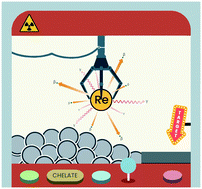Bifunctional chelators for radiorhenium: past, present and future outlook
Abstract
Targeted radionuclide therapy (TRNT) is an ever-expanding field of nuclear medicine that provides a personalised approach to cancer treatment while limiting toxicity to normal tissues. It involves the radiolabelling of a biological targeting vector with an appropriate therapeutic radionuclide, often facilitated by the use of a bifunctional chelator (BFC) to stably link the two entities. The radioisotopes of rhenium, 186Re (t1/2 = 90 h, 1.07 MeV β−, 137 keV γ (9%)) and 188Re (t1/2 = 16.9 h, 2.12 MeV β−, 155 keV γ (15%)), are particularly attractive for radiotherapy because of their convenient and high-abundance β−-particle emissions as well as their imageable γ-emissions and chemical similarity to technetium. As a transition metal element with multiple oxidation states and coordination numbers accessible for complexation, there is great opportunity available when it comes to developing novel BFCs for rhenium. The purpose of this review is to provide a recap on some of the past successes and failings, as well as show some more current efforts in the design of BFCs for 186/188Re. Future use of these radionuclides for radiotherapy depends on their cost-effective availability and this will also be discussed. Finally, bioconjugation strategies for radiolabelling biomolecules with 186/188Re will be touched upon.

- This article is part of the themed collection: Bioorthogonal and click chemistry: Celebrating the 2022 Nobel Prize in Chemistry


 Please wait while we load your content...
Please wait while we load your content...